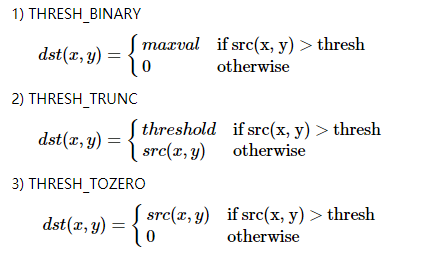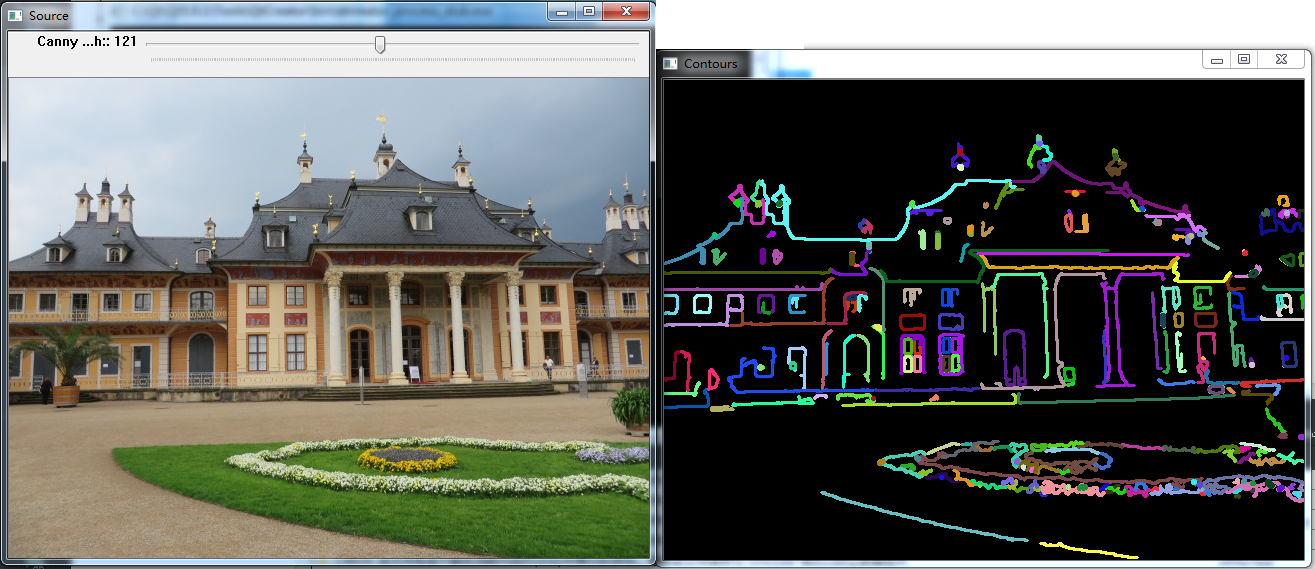1 基于阈值
1.1 灰度阈值化
灰度阈值化,是最简单,速度最快的图像分割方法,广泛用于硬件图像处理领域 (例如,基于 FPGA 的实时图像处理等)。
设输入图像 ff,输出图像 gg,则阈值化公式为:
g(i,j)={10当 f(i, j) ≥ T 时当 f(i, j) < T 时g(i,j)={1当 f(i, j) ≥ T 时0当 f(i, j) < T 时
即,遍历图像中所有像素,当像素值 f(i,j)≥Tf(i,j)≥T 时,分割后的图像元素 g(i,j)g(i,j) 是物体像素,否则为背景像素。
当各物体不接触,且 物体和背景的灰度值差别比较明显 时,灰度阈值化是非常合适的分割方法。

1.2 固定阈值化
固定阈值化函数为 threshold,如下:
1 double cv::threshold (
2 InputArray src, // 输入图像 (单通道,8位或32位浮点型)
3 OutputArray dst, // 输出图像 (大小和类型,都同输入)
4 double thresh, // 阈值
5 double maxval, // 最大灰度值(使用 THRESH_BINARY 和 THRESH_BINARY_INV类型时)
6 int type // 阈值化类型(THRESH_BINARY, THRESH_BINARY_INV; THRESH_TRUNC; THRESH_TOZERO, THRESH_TOZERO_INV)
7 )

1.3 自适应阈值化
整幅图像使用同一个阈值做二值化,对于一些情况并不适用,尤其是当图像中的不同区域,照明条件各不相同时。这种情况下,就需要自适应阈值算法,该算法可根据像素所在的区域,来确定一个适合的阈值。因此,对于一幅图中光照不同的区域,可取各自不同的阈值做二值化。
OpenCV 中,自适应阈值化函数为 adaptiveThreshold(),如下:
1 void cv::adaptiveThreshold (
2 InputArray src, //
3 OutputArray dst, //
4 double maxValue, //
5 int adaptiveMethod, // 自适应阈值算法,目前有 ADAPTIVE_THRESH_MEAN_C 和 ADAPTIVE_THRESH_GAUSSIAN_C 两种
6 int thresholdType, // 阈值化类型,同 threshold() 中的 type
7 int blockSize, // 邻域大小
8 double C //
9 )
1.4 示例
1)阈值化类型和阈值可选的代码示例,摘自 OpenCV 例程,略作修改
1 #include "opencv2/imgproc.hpp"
2 #include "opencv2/imgcodecs.hpp"
3 #include "opencv2/highgui.hpp"
4
5 using namespace cv;
6
7 int threshold_value = 0;
8 int threshold_type = 3;
9 int const max_value = 255;
10 int const max_type = 4;
11 int const max_BINARY_value = 255;
12
13 Mat src, src_gray, dst;
14 const char* window_name = "Threshold Demo";
15
16 const char* trackbar_type = "Type:
0: Binary
1: Binary Inverted
2: Truncate
3: To Zero
4: To Zero Inverted";
17 const char* trackbar_value = "Value";
18
19 void Threshold_Demo(int, void*);
20
21 int main( int, char** argv )
22 {
23 // 读图
24 src = imread("Musikhaus.jpg",IMREAD_COLOR);
25 if( src.empty() )
26 return -1;
27
28 // 转化为灰度图
29 cvtColor( src, src_gray, COLOR_BGR2GRAY );
30 // 显示窗口
31 namedWindow( window_name, WINDOW_AUTOSIZE );
32 // 滑动条 - 阈值化类型
33 createTrackbar( trackbar_type, window_name, &threshold_type,max_type,Threshold_Demo);
34 // 滑动条 - 阈值
35 createTrackbar( trackbar_value,window_name, &threshold_value,max_value,Threshold_Demo);
36
37 Threshold_Demo(0, 0);
38
39 waitKey(0);
40 }
41
42 void Threshold_Demo(int, void*)
43 {
44 /* 0: Binary
45 1: Binary Inverted
46 2: Threshold Truncated
47 3: Threshold to Zero
48 4: Threshold to Zero Inverted
49 */
50 threshold(src_gray, dst, threshold_value, max_BINARY_value, threshold_type);
51 imshow(window_name, dst);
52 }
2)全局阈值和自适应阈值的比较,代码如下:
1 #include <opencv2/core.hpp>
2 #include <opencv2/imgproc.hpp>
3 #include <opencv2/highgui.hpp>
4
5 using namespace cv;
6
7 int main()
8 {
9 // read an image
10 Mat img = imread("sudoku.png");
11 cvtColor(img,img,COLOR_BGR2GRAY);
12
13 // adaptive
14 Mat dst1, dst2, dst3;
15 threshold(img, dst1, 100, 255, THRESH_BINARY);
16 adaptiveThreshold(img, dst2, 255,ADAPTIVE_THRESH_MEAN_C ,THRESH_BINARY,11,2);
17 adaptiveThreshold(img, dst3, 255,ADAPTIVE_THRESH_GAUSSIAN_C ,THRESH_BINARY,11,2);
18
19 // show images
20 imshow("img", img);
21 imshow("threshold", dst1);
22 imshow("mean_c", dst2);
23 imshow("gauss_c", dst3);
24
25 waitKey(0);
26 }
对比显示的结果为:

2 基于边缘
前一篇 <OpenCV 之 边缘检测> 中,介绍了三种常用的边缘检测算子: Sobel, Laplace 和 Canny 算子。
实际上,边缘检测的结果是一个个的点,并不能作为图像分割的结果,必须采用进一步的处理,将边缘点沿着图像的边界连接起来,形成边缘链。
2.1 轮廓函数
OpenCV 中,可在图像的边缘检测之后,使用 findContours 寻找到轮廓,该函数参数如下:
image 一般为二值化图像,可由 compare, inRange, threshold , adaptiveThreshold, Canny 等函数来获得;
hierarchy 为可选的参数,如果不选择该参数,则可得到 findContours 函数的第二种形式;
1 // 形式一
2 void findContours (
3 InputOutputArray image, // 输入图像
4 OutputArrayOfArrays contours, // 检测到的轮廓
5 OutputArray hierarchy, // 可选的输出向量
6 int mode, // 轮廓获取模式 (RETR_EXTERNAL, RETR_LIST, RETR_CCOMP,RETR_TREE, RETR_FLOODFILL)
7 int method, // 轮廓近似算法 (CHAIN_APPROX_NONE, CHAIN_APPROX_SIMPLE, CHAIN_APPROX_TC89_L1, CHAIN_APPROX_TC89_KCOS)
8 Point offset = Point() // 轮廓偏移量
9 )
10 // 形式二
11 void findContours (
12 InputOutputArray image,
13 OutputArrayOfArrays contours,
14 int mode,
15 int method,
16 Point offset = Point()
17 )
drawContours 函数参数如下:
1 void drawContours (
2 InputOutputArray image, // 目标图像
3 InputArrayOfArrays contours, // 所有的输入轮廓
4 int contourIdx, //
5 const Scalar & color, // 轮廓颜色
6 int thickness = 1, // 轮廓线厚度
7 int lineType = LINE_8, //
8 InputArray hierarchy = noArray(), //
9 int maxLevel = INT_MAX, //
10 Point offset = Point() //
11 )
2.2 例程
代码摘自 OpenCV 例程,略有修改
1 #include "opencv2/imgcodecs.hpp"
2 #include "opencv2/highgui.hpp"
3 #include "opencv2/imgproc.hpp"
4
5 using namespace cv;
6 using namespace std;
7
8 Mat src,src_gray;
9 int thresh = 100;
10 int max_thresh = 255;
11 RNG rng(12345);
12
13 void thresh_callback(int, void* );
14
15 int main( int, char** argv )
16 {
17 // 读图
18 src = imread("Pillnitz.jpg", IMREAD_COLOR);
19 if (src.empty())
20 return -1;
21
22 // 转化为灰度图
23 cvtColor(src, src_gray, COLOR_BGR2GRAY );
24 blur(src_gray, src_gray, Size(3,3) );
25
26 // 显示
27 namedWindow("Source", WINDOW_AUTOSIZE );
28 imshow( "Source", src );
29
30 // 滑动条
31 createTrackbar("Canny thresh:", "Source", &thresh, max_thresh, thresh_callback );
32
33 // 回调函数
34 thresh_callback( 0, 0 );
35
36 waitKey(0);
37 }
38
39 // 回调函数
40 void thresh_callback(int, void* )
41 {
42 Mat canny_output;
43 vector<vector<Point> > contours;
44 vector<Vec4i> hierarchy;
45
46 // canny 边缘检测
47 Canny(src_gray, canny_output, thresh, thresh*2, 3);
48
49 // 寻找轮廓
50 findContours( canny_output, contours, hierarchy, RETR_TREE, CHAIN_APPROX_SIMPLE, Point(0, 0) );
51
52 Mat drawing = Mat::zeros( canny_output.size(), CV_8UC3);
53
54 // 画出轮廓
55 for( size_t i = 0; i< contours.size(); i++ ) {
56 Scalar color = Scalar( rng.uniform(0, 255), rng.uniform(0,255), rng.uniform(0,255) );
57 drawContours( drawing, contours, (int)i, color, 2, 8, hierarchy, 0, Point() );
58 }
59
60 namedWindow( "Contours", WINDOW_AUTOSIZE );
61 imshow( "Contours", drawing );
62 }
以 Dresden 的 Schloss Pillnitz 为源图,输出如下:
